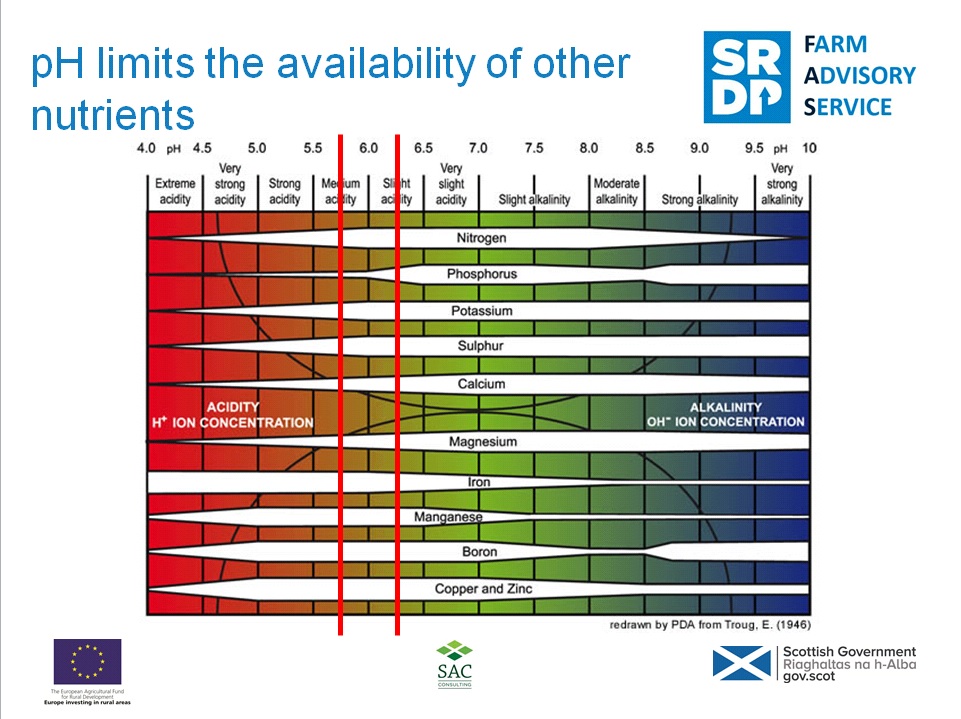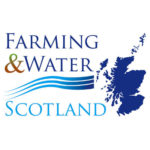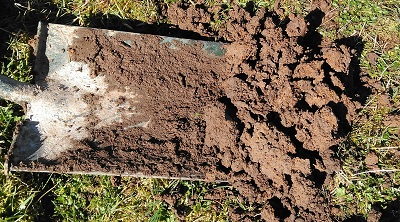Kintyre Soil and Nutrient Network: Second Meeting – Event Summary
20 September 2017Soil Nutrients – The Building Blocks of Productivity
Despite the weather there was a great turnout for this event and Agricultural Consultant David Ross delivered a thorough and detailed approach to show why it is so i mportant to get the basics correct. A second round of soil sampling highlighted what the various crops had taken from the soil in P & K, especially the field of oats. Leaching, with the inclement summer also had a bearing. David reiterated how important it is to check soils and the need for using a spade!
mportant to get the basics correct. A second round of soil sampling highlighted what the various crops had taken from the soil in P & K, especially the field of oats. Leaching, with the inclement summer also had a bearing. David reiterated how important it is to check soils and the need for using a spade!
pH and getting indices correct between 5.8 and 6.2.
P&K are the key nutrients which, when corrected in conjunction with pH, maximise the utilisation of inorganic fertilisers. Sulphur was discussed, and the experiment currently being conducted by David highlighted the benefits to yield from inputted sulphur.
What next for Rhoin Farm?
Moving forwards at Rhoin, the findings discussed at this event will be addressed, especially focussing on the the nutrient values of FYM and slurry.
You can download a copy of PLANET software – a free programme to help you manage your fields and nutrient budget.
Rhoin Farm is one of 12 host farms across Scotland as part of the Soil & Nutrient Network. These farms are taking a ‘before and after’ look at how to protect and improve farm soils and make best use of both organic and inorganic fertilisers, saving money, benefitting yields and improving farm efficiency and resilience.
The event summary from the first meeting of the Rhoin Farm group is available to read here. You can read more about some of the other current and historic host farms on the Far ming & Water Scotland webpage.
ming & Water Scotland webpage.
- Valuing Your Soils – Practical Guidance for Scottish Farmers
- This brochure includes useful information about Scotland's agricultural soils and practical advice outlining the upfront financial savings and business benefits of better soil management and the efficient use of resources. Action and problem-specific 'field-sheets' are designed for busy farmers with limited time for reading.
- Topics: Soils, Climate Change, Water Management and Crops and Soils
- Visual Evaluation of Soil Structure (VESS) Score Chart
- This is a downloadable copy of the Visual Evaluation of Soil Structure (VESS) score chart for use in-field.
- Topics: Soils
- Technical Note (TN656): Soil Information, Texture & Liming Recommendations
- • Web based access to information on your soils on your farm is described. • Soil texture classes of mineral soils are described and identified by hand texturing. • Liming recommendations for different soils and managements are tabulated.
- Topics: Soils
- Technical Note (TN668): Managing Soil Phosphorus
- Efficient soil P management is challenging due to the varying ability of soils to mediate and regulate plant available forms of P. Farmers and land managers in Scotland are now able to access farm level information about their soils making it possible to provide more accurate P management advice.
- Topics: Crops and Soils
- Technical Note (TN685): Sulphur Recommendations for Crops
- This technical note examines the use of sulphur (S) for crops, and outlines sulphur deficiency, recommendations for use and availability of nutrients in organic fertilisers.
- Farming For A Better Climate: Practical Guide – Improving Soil Quality
- This Practical Guide concentrates on how we can improve soil quality to help us to adapt to climate change.
- Topics: Soils
- Farming For A Better Climate: Practical Guide – Soil Management
- Topics: Soils
- Farming For a Better Climate: Practical Guide on Optimising Organic Nitrogen
- This Farming For a Better Climate document was included as part of the delegate pack for those who attended the FAS event 'Waste more, fert. less!'.
- Topics: Climate Change
- Practical Guide: Managing Soil Phosphorus
- This Practical Guide will help you manage the phosphorus in your soils. It will help you understand the risk of phosphorus pollution and how you can reduce bagged fertiliser costs in grassland by incorporating nitrogen fixing clover into your sward.
- Topics: Soils, Climate Change and Water Management
- Practical Guide: Soil sampling I – How to take a soil sample
- This practical guide details what is required to take a soil sample for analysis that is representative of the area sampled.
- Topics: Soils, Climate Change and Water Management
- Practical Guide: Soil sampling II – Benefits to your business
- This practical guide details how soil sampling can benefit businesses by increasing productivity and create efficiencies on fertiliser inputs through better nutrient planning.
- Topics: Soils, Climate Change and Water Management
- Practical Guide: Nutrient budgeting I – The Benefits to your Business
- This practical guide looks at the benefits of creating and using a nutrient budget for your farm business.
- Topics: Climate Change
- Practical Guide: Nutrient Budgeting II – Getting Started
- This practical guide looks at what factors you need to consider when making a nutrient budget for your farm, fertiliser recommendations and how to get the most out of your nutrient budget.
- Topics: Climate Change
Sign up to the FAS newsletter
Receive updates on news, events and publications from Scotland’s Farm Advisory Service

